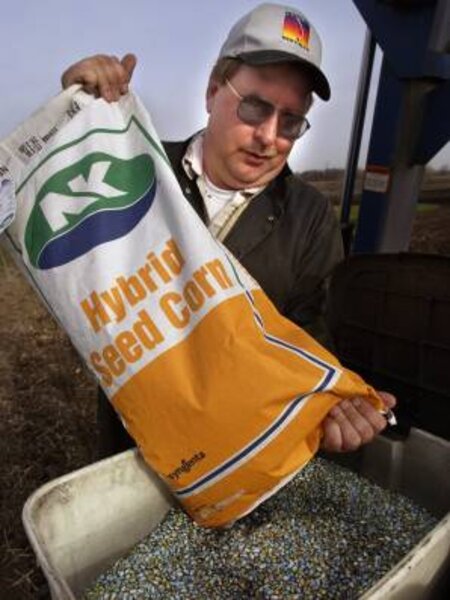More herbicide use reported on genetically modified crops
Loading...
A report released by the Organic Center found that the amount of herbicides used on genetically engineered crops has increased in the past 10 years, not decreased as might be expected. Since many genetically engineered crops were modified so that farmers could spray Roundup, or Glyphosate, to kill the weeds in their fields but not the crops themselves, the expectation was that less herbicide would be required. But the new report found that this is not what happened.
The authors of the report, entitled “Impacts of Genetically Engineered Crops on Pesticide Use,” used US Department of Agriculture data to look at America’s three largest genetically engineered crops – soybeans, corn, and cotton. They found that the amount of herbicides used on them has increased from 1996 to 2008 by approximately 7 or 8 percent, with a particularly sharp increase from 2005 on.
In particular, the amount of Roundup that is used on genetically engineered crops has multiplied several times during the time period, says the report’s main author, Charles Benbrook, who's the chief scientist at the Organic Center.
“This big increase in herbicide is driven largely by the emergence of Roundup-resistant weeds,” Dr. Benbrook says. But “industry is still saying to the public that genetic engineering [has] reduced herbicide use.”
Benbrook found that Roundup-resistant weeds have become a particularly big problem in soybeans. Roundup originally killed all weeds, leaving only soybeans in the fields, but after a few years, farmers had to use more Roundup as well as the older, more toxic chemicals to kill the weeds, according to the authors of the report.
Troy Roush, a farmer in Indiana, says resistant weeds became such a big problem that this year he decided to switch back to conventional soybeans.
“The only advantage a genetically modified soybean has over the value of (conventional soy) is diminished,” Mr. Roush says. “We might as well not pay for the technology and use conventional seeds.”
His fields of genetically engineered soybean became infested with “mare’s tail”, a bushy weed that looks like the tail of a horse, and with genetically-engineered corn, he says. Because Roush rotates corn and soybeans on the same field, the Roundup-resistant corn actually became a weed when it went to seed the following year.
Because of these problems, Roush is now back at growing soybeans the old way and using a more toxic 2,4-D herbicide. He is saving money on seeds (genetically engineered seeds cost five times more than the seeds a farmer saves himself), and he can make more from selling his crop to customers in the European Union and Japan, who prefer non-genetically modified soy.
The authors of the report also found that the amount of insecticide used on genetically modified crops decreased during the same time period (although by a smaller amount). According to the report, herbicide use grew by 383 million pounds from 1996 to 2008, while insecticide use decreased by 64 million pounds due to the adoption of crops that are engineered to resist insects.
Farmer John Reifsteck from Illinois, says he used to have a problem with root worms that chewed the roots off his corn plants, causing them to fall over. Now that he’s growing genetically modified corn, the worms no longer come. That’s because genetically engineered corn plants contain a toxin that is safe for humans, but repels the worms.
“It irritates their stomach, they don’t like it, they quit feeding, and they move away,” Mr. Reifsteck explains.
Before bioengineering, Reifsteck used a toxic insecticide on his corn, which he described as “the most dangerous product that I handle.” He had to wear a respirator and rubber gloves, and have blood tests, he says. Now he doesn’t need to treat the corn as much because it’s engineered to repel worms on its own.
“I’m happy or I wouldn’t be using them,” he says about genetically engineered crops.
Karen Batra, the spokeswoman for the Biotechnology Industry Organization, and Bob Callanan, of the American Soybean Association, also say that farmers are happy with bioengineered crops. That the majority of farmers adopted the technology speaks for itself, they say. They also point out that the Organic Center’s report considered all herbicides as one group, without making a distinction between the more toxic herbicides, which are now being used less, and weed-killers such as Roundup, which are generally considered more benign.
On the issue of weed resistance, Mr. Callanan of the Soybean Association has a different solution. Although he admits that resistance to Roundup became a problem about three years ago, he says the best way to tackle weed resistance is with new technology. A soybean called Liberty Link, that is engineered to be resistant to a different type of herbicide, is currently being introduced. Rotating Liberty Link and Roundup Ready crops will reduce resistance, he says.
“Every farmer I know is using less herbicides than they ever had in the past. It’s a cleaner, better crop than it was,” Callanan says about genetically engineered soybeans.
But organic food advocates say that the bioengineering industry is on a slippery slope, and as scientists engineer plants to be resistant to new types of herbicides, more chemical residues are going to end up in food and in the environment.
Efforts are currently underway to engineer a corn variety that is resistant to 2,4-D, which is considered a carcinogen, says Bill Freese, a policy analyst at the Center for Food Safety who worked on the report.
If the project is successful, farmers will be able to spray the herbicide directly on the corn, rather than use hooded sprayers or spray before seedlings sprouted as they have done in the past, he says.
“That’s bad news because that will mean more residues on the corn,” Mr. Freese says. “We see that as very much the wrong approach because it’s going to mean even more use of these nasty herbicides, more pollution of the environment, and more impact on farmers as well as consumers.”
Editor’s note: For more articles about the environment, see the Monitor’s main environment page, which offers information on many environment topics. Also, check out our Bright Green blog archive and our RSS feed.






